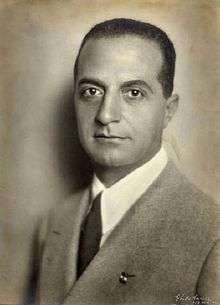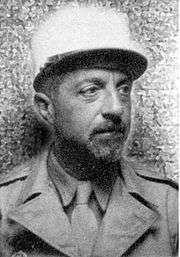Giuseppe Bottai
| Giuseppe Bottai | |
|---|---|
 Giuseppe Bottai as Minister of Education, 1937 | |
| Minister of National Education | |
|
In office 15 November 1936 – 5 February 1943 | |
| Prime Minister | Benito Mussolini |
| Preceded by | Cesare Maria De Vecchi |
| Succeeded by | Carlo Alberto Biggini |
| Governor of Addis Ababa | |
|
In office 5 May 1936 – 27 May 1936 | |
| Monarch | Victor Emmanuel III |
| Preceded by | Office created |
| Succeeded by | Alfredo Siniscalchi |
| Governor of Rome | |
|
In office 23 January 1935 – 15 November 1936 | |
| Preceded by | Francesco Boncompagni Ludovisi |
| Succeeded by | Piero Colonna |
| Member of the Chamber of Fasci and Corporations | |
|
In office 20 April 1929 – 5 August 1943 | |
| Personal details | |
| Born |
3 September 1895 Rome, Italy |
| Died |
9 January 1959 (aged 63) Rome, Italy |
| Political party |
Italian Fasci of Combat (1919–1921) National Fascist Party (1921–1943) |
| Alma mater | Sapienza University of Rome |
| Profession | Journalist, soldier |
| Military service | |
| Allegiance |
|
| Service/branch |
|
| Years of service | 1915–1917; 1935–1936; 1943–1948 |
| Rank | |
| Unit | 1st Cavalry Regiment (France) |
| Battles/wars | |
Giuseppe Bottai (3 September 1895 – 9 January 1959) was an Italian journalist, and member of the National Fascist Party of Benito Mussolini.
Biography
Early life
Born in Rome, Giuseppe was son of Luigi, a wine dealer with republican sympathies, and Elena Cortesia. He was graduated at Liceo Torquato Tasso, and attended to the Sapienza University of Rome until the 1915, when Italy declared war to the Central Powers: in the same year he left his studies to enlist himself in the Italian Royal Army. Wounded in battle, he obtained a Medal of Military Valor after the World War I.[1]
In 1919, Bottai met Benito Mussolini during a Futurist meeting,[2] and contributed to establish the Fasci Italiani di Combattimento ("Italian Fasci of Combat"). In 1921, Bottai ended his studies at law faculty and became a freemason, member of the Gran Loggia d'Italia.[3] At the same time he also started a journalist career in the Il Popolo d'Italia, newspaper of the recently-founded National Fascist Party. During the March on Rome, Bottai was along with Ulisse Igliori and Gino Calza-Bini, the head of the Roman squadrismo, supporting Blackshirts' political violence.
Political career

After 1921 election, Bottai was elected in the Chamber of Deputies for the National Blocs, but was removed for his young age. He returned to the Chamber in 1924, maintaining the office until 1943. In 1923, he became leader of the intransigent, national syndicalist and revolutionary faction of the Fascism. To support his ideas, Bottai founded Critica fascista ("Fascist Critic"), a cultural periodical, co-operating with other leftist fascists like Filippo De Pisis, Renato Guttuso and Mario Mafai.[4] Bottai worked to the Ministry of Corporations, introducing the Labour Charter and planning a "Corporative Academic Pole" in Pisa, from 1926 to 1932, when he was excluded by Mussolini from the Ministry.[5] In 1933, Bottai established and chaired the National Institute of the Social Security (Italian: Istituto nazionale della previdenza sociale, INPS). After, he was appointed Fascist Governor of Rome (1935–1936) but resigned to fight in the Second Italo-Ethiopian War with the rank of major. In 5 May 1936, Bottai and Pietro Badoglio entered in Addis Abeba, and Bottai was appointed as City Governor. After the war, Bottai returned in Rome to be Education Minister. During his ministry, Bottai proclaimed a law (the so-called "Bottai Law") on safeguarding public and cultural heritage and the preservation of natural beauties .[6] He also co-worked with art critics Giulio Carlo Argan and Cesare Brandi to improve the Italian cultural life.
In the late 1930s, Bottai became more radical and a Germanophile. In 1938 he expressed support to Radical Laws against the Italian Jews and in 1940 he founded Primato ("Record"), a magazine that supported the Aryan race's supremacy and war interventionism.[7] Bottai thought that the "Fascist Revolution" was incomplete, and only a return to the original fascism, pseudo-socialist and anti-bourgeois, would save Europe. However, the Italian intervention in World War II resulted in disaster. The Campaign on the Eastern Front caused the death or dispersion of approximately 77,000 soldiers, with more than 39,000 injured. Bottai voted for Mussolini's arrest proposed by Dino Grandi on 25 July 1943, when Italy's defeat became evident. In 1944, the Italian Social Republic condemned Bottai to death, during the Verona trial, but Bottai was hiding in a Roman convent.[8]
World War II and final years
In 1944, Bottai enlisted in the French Foreign Legion, with the pseudodyn Andrea Battaglia. He fought in Provence during the Operation Dragoon and then in the Western Allied invasion of Germany. At the war's end, Bottai remained in France, and continued to serve in Foreign Legion until 1948, when he was discharged. For his role in the final stages of World War II, he got an amnesty for his role in Fascism.
Returned in Italy in 1953, Bottai founded the periodical ABC (not to be confused with the same-name magazine) and Il Popolo di Roma, financed by ex-fascist Vittorio Cini, who supported centrist and conservative views. He died in Rome in 1959. At his funeral participated also Aldo Moro, like his father was a Bottai's friend and assistant during his career.[9]
Works
- Trade organisation in Italy under the act and regulations on collective relations in connection with employment
- Economia fascista (1930)
- Grundprinzipien des korporativen Aufbaus in Italien (1933)
- Esperienza corporativa (1929–1935) (1935)
- Corporazioni (1935)
- Scritti giuridici in onore di Santi Romano ... (1940)
- Funzione di Roma nella vita culturale e scientifica della nazione (1940)
- Pagine di critica fascista (1915–1926) (1941, edited by F. M. Pacces)
- Romanità e germanesimo: letture tenute per il Lyceum di Firenze (1941, edited by Jolanda de Blasi)
- Von der römischen zur faschistischen Korporation (1942)
- Köpfe des risorgimento (1943)
- Contributi all'elaborazione delle scienze corporative (1939-XVIII—1942-XX) (1943)
- Vent 'anni e un giorno, 24 luglio 1943 (1949). Republished as Vent'anni e un giorno (24 luglio 1943) (1977).
- Legione è il mio nome (1950). Republished as Legione è il mio nome: il coraggioso epilogo di un gerarca del fascismo (I memoriali) (1999, edited by Marcello Staglieno)
- Scritti (1965, edited by Roberto Bartolozzi and Riccardo Del Giudice)
- Diario, 1935–1944 (1982, edited by Giordano Bruno Guerri)
- Carteggio 1940–1957, correspondence between Bottai and Don Giuseppe De Luca; edited by Renzo De Felice and Renato Moro (1989)
- La politica delle arti: Scritti, 1918–1943 (1992, edited by Alessandro Masi).
- Quaderni giovanili: 1915–1920 (Atti testimonianze convegni) (1996).
Notes
- Incontro con Bottai by Mario Carli and Bruno D'Agostini (1938)
- Giuseppe Bottai, un fascista critico : ideologia e azione del gerarca che avrebbe voluto portare l'intelligenza nel fascismo e il fascismo alla liberalizzazione by Giordano Bruno Guerri (1976 – Republished as Giuseppe Bottai, fascista, 1996).
- Bottai : il fascismo come rivoluzione del capitale (1978, edited by Anna Panicali)
- Scuola e la pedagogia del fascismo by Maria Bellucci and Michele Ciliberto (1978).
- Giuseppe Bottai e la riforma fascista della scuola by Rino Gentili. (1979)
- Bottai tra capitale e lavoro by Amleto Di Marcantonio (1980)
- Biographical Dictionary of the Extreme Right Since 1890 by Philip Rees (1990)
References
- ↑ Sabino Cassese (1971). Bottai, Giuseppe – Dizionario Biografico degli Italiani. Treccani.
- ↑ Maddalena, Carli (2010). "Un movimento artistico crea un partito politico : il futurismo italiano tra avanguardismo e normalizzazione". Memoria e ricerca.
- ↑ Michele Terzaghi (1950). Fascismo e massoneria. Arnaldo Forni Editore. p. 171.
- ↑ Berto Ricci (1984). Lo Scrittore Italiano. Ciarrapico.
- ↑ Paolo Passaniti (2007). Storia del diritto del lavoro. FrancoAngeli. pp. 573–574.
- ↑ Vittorio Emiliani (2011). Tutela del paesaggio ed Unità nazionale. Alinea Editrice.
- ↑ Roberto Finzi (2008). La cultura italiana e le leggi antiebraiche del 1938. Carocci. p. 915.
- ↑ Enzo Forcella (1999). La resistenza in convento. Einaudi.
- ↑ Aldo Moro (2009). Lettere dalla prigionia. Einaudi.
External links
- Newspaper clippings about Giuseppe Bottai in the 20th Century Press Archives of the German National Library of Economics (ZBW)
